Chenwei Zhang
From Web Search towards Agentic Deep Research: Incentivizing Search with Reasoning Agents
Jun 23, 2025Abstract:Information retrieval is a cornerstone of modern knowledge acquisition, enabling billions of queries each day across diverse domains. However, traditional keyword-based search engines are increasingly inadequate for handling complex, multi-step information needs. Our position is that Large Language Models (LLMs), endowed with reasoning and agentic capabilities, are ushering in a new paradigm termed Agentic Deep Research. These systems transcend conventional information search techniques by tightly integrating autonomous reasoning, iterative retrieval, and information synthesis into a dynamic feedback loop. We trace the evolution from static web search to interactive, agent-based systems that plan, explore, and learn. We also introduce a test-time scaling law to formalize the impact of computational depth on reasoning and search. Supported by benchmark results and the rise of open-source implementations, we demonstrate that Agentic Deep Research not only significantly outperforms existing approaches, but is also poised to become the dominant paradigm for future information seeking. All the related resources, including industry products, research papers, benchmark datasets, and open-source implementations, are collected for the community in https://github.com/DavidZWZ/Awesome-Deep-Research.
PersonaAgent: When Large Language Model Agents Meet Personalization at Test Time
Jun 06, 2025Abstract:Large Language Model (LLM) empowered agents have recently emerged as advanced paradigms that exhibit impressive capabilities in a wide range of domains and tasks. Despite their potential, current LLM agents often adopt a one-size-fits-all approach, lacking the flexibility to respond to users' varying needs and preferences. This limitation motivates us to develop PersonaAgent, the first personalized LLM agent framework designed to address versatile personalization tasks. Specifically, PersonaAgent integrates two complementary components - a personalized memory module that includes episodic and semantic memory mechanisms; a personalized action module that enables the agent to perform tool actions tailored to the user. At the core, the persona (defined as unique system prompt for each user) functions as an intermediary: it leverages insights from personalized memory to control agent actions, while the outcomes of these actions in turn refine the memory. Based on the framework, we propose a test-time user-preference alignment strategy that simulate the latest n interactions to optimize the persona prompt, ensuring real-time user preference alignment through textual loss feedback between simulated and ground-truth responses. Experimental evaluations demonstrate that PersonaAgent significantly outperforms other baseline methods by not only personalizing the action space effectively but also scaling during test-time real-world applications. These results underscore the feasibility and potential of our approach in delivering tailored, dynamic user experiences.
CryoSAMU: Enhancing 3D Cryo-EM Density Maps of Protein Structures at Intermediate Resolution with Structure-Aware Multimodal U-Nets
Mar 26, 2025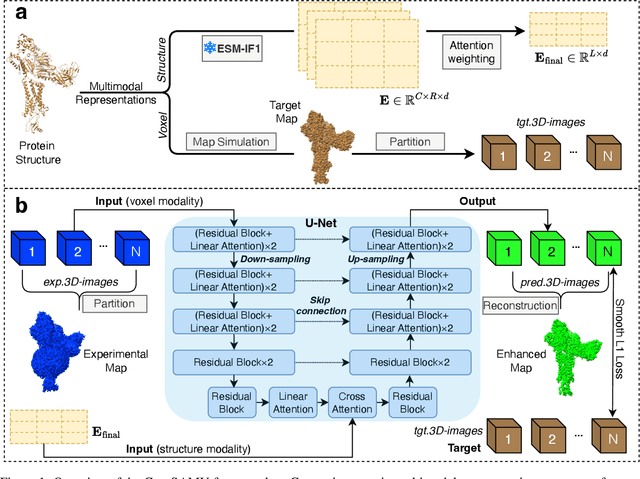


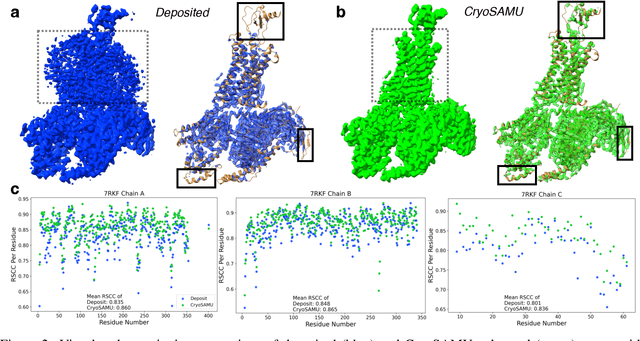
Abstract:Enhancing cryogenic electron microscopy (cryo-EM) 3D density maps at intermediate resolution (4-8 {\AA}) is crucial in protein structure determination. Recent advances in deep learning have led to the development of automated approaches for enhancing experimental cryo-EM density maps. Yet, these methods are not optimized for intermediate-resolution maps and rely on map density features alone. To address this, we propose CryoSAMU, a novel method designed to enhance 3D cryo-EM density maps of protein structures using structure-aware multimodal U-Nets and trained on curated intermediate-resolution density maps. We comprehensively evaluate CryoSAMU across various metrics and demonstrate its competitive performance compared to state-of-the-art methods. Notably, CryoSAMU achieves significantly faster processing speed, showing promise for future practical applications. Our code is available at https://github.com/chenwei-zhang/CryoSAMU.
SCKD: Semi-Supervised Cross-Modality Knowledge Distillation for 4D Radar Object Detection
Dec 19, 2024Abstract:3D object detection is one of the fundamental perception tasks for autonomous vehicles. Fulfilling such a task with a 4D millimeter-wave radar is very attractive since the sensor is able to acquire 3D point clouds similar to Lidar while maintaining robust measurements under adverse weather. However, due to the high sparsity and noise associated with the radar point clouds, the performance of the existing methods is still much lower than expected. In this paper, we propose a novel Semi-supervised Cross-modality Knowledge Distillation (SCKD) method for 4D radar-based 3D object detection. It characterizes the capability of learning the feature from a Lidar-radar-fused teacher network with semi-supervised distillation. We first propose an adaptive fusion module in the teacher network to boost its performance. Then, two feature distillation modules are designed to facilitate the cross-modality knowledge transfer. Finally, a semi-supervised output distillation is proposed to increase the effectiveness and flexibility of the distillation framework. With the same network structure, our radar-only student trained by SCKD boosts the mAP by 10.38% over the baseline and outperforms the state-of-the-art works on the VoD dataset. The experiment on ZJUODset also shows 5.12% mAP improvements on the moderate difficulty level over the baseline when extra unlabeled data are available. Code is available at https://github.com/Ruoyu-Xu/SCKD.
Shopping MMLU: A Massive Multi-Task Online Shopping Benchmark for Large Language Models
Oct 28, 2024



Abstract:Online shopping is a complex multi-task, few-shot learning problem with a wide and evolving range of entities, relations, and tasks. However, existing models and benchmarks are commonly tailored to specific tasks, falling short of capturing the full complexity of online shopping. Large Language Models (LLMs), with their multi-task and few-shot learning abilities, have the potential to profoundly transform online shopping by alleviating task-specific engineering efforts and by providing users with interactive conversations. Despite the potential, LLMs face unique challenges in online shopping, such as domain-specific concepts, implicit knowledge, and heterogeneous user behaviors. Motivated by the potential and challenges, we propose Shopping MMLU, a diverse multi-task online shopping benchmark derived from real-world Amazon data. Shopping MMLU consists of 57 tasks covering 4 major shopping skills: concept understanding, knowledge reasoning, user behavior alignment, and multi-linguality, and can thus comprehensively evaluate the abilities of LLMs as general shop assistants. With Shopping MMLU, we benchmark over 20 existing LLMs and uncover valuable insights about practices and prospects of building versatile LLM-based shop assistants. Shopping MMLU can be publicly accessed at https://github.com/KL4805/ShoppingMMLU. In addition, with Shopping MMLU, we host a competition in KDD Cup 2024 with over 500 participating teams. The winning solutions and the associated workshop can be accessed at our website https://amazon-kddcup24.github.io/.
Synthetic High-resolution Cryo-EM Density Maps with Generative Adversarial Networks
Jul 24, 2024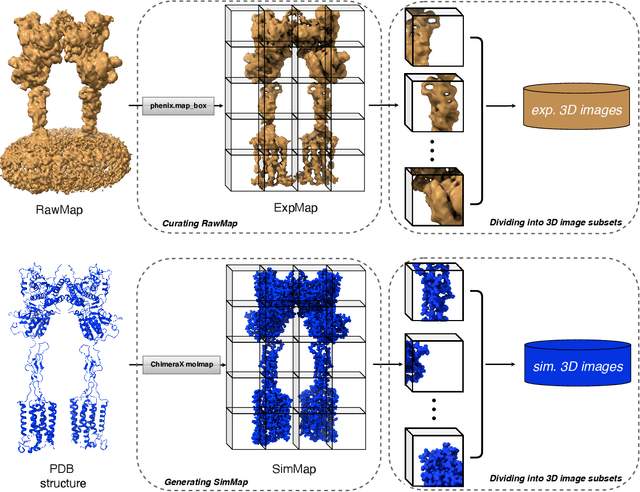

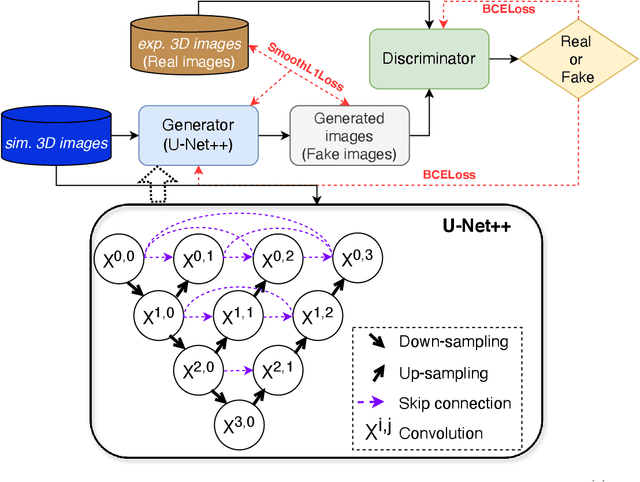
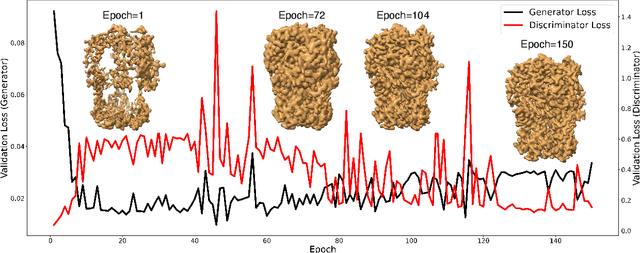
Abstract:Generating synthetic cryogenic electron microscopy (cryo-EM) 3D density maps from molecular structures has potential important applications in structural biology. Yet existing simulation-based methods cannot mimic all the complex features present in experimental maps, such as secondary structure elements. As an alternative, we propose struc2mapGAN, a novel data-driven method that employs a generative adversarial network (GAN) to produce high-resolution experimental-like density maps from molecular structures. More specifically, struc2mapGAN uses a U-Net++ architecture as the generator, with an additional L1 loss term and further processing of raw experimental maps to enhance learning efficiency. While struc2mapGAN can promptly generate maps after training, we demonstrate that it outperforms existing simulation-based methods for a wide array of tested maps and across various evaluation metrics. Our code is available at https://github.com/chenwei-zhang/struc2mapGAN.
APTNESS: Incorporating Appraisal Theory and Emotion Support Strategies for Empathetic Response Generation
Jul 23, 2024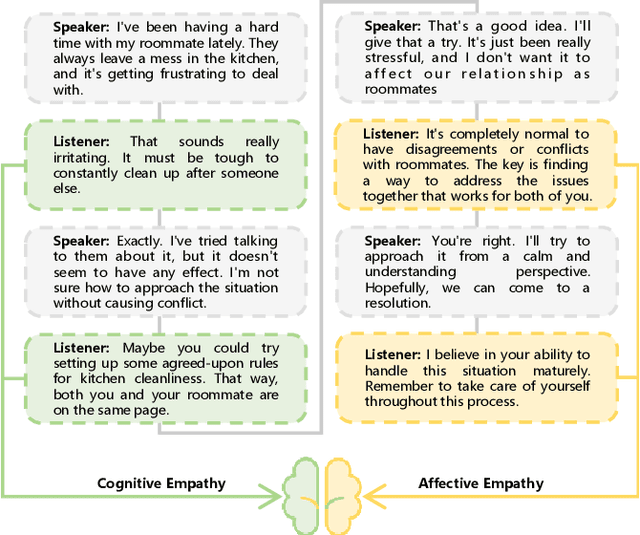

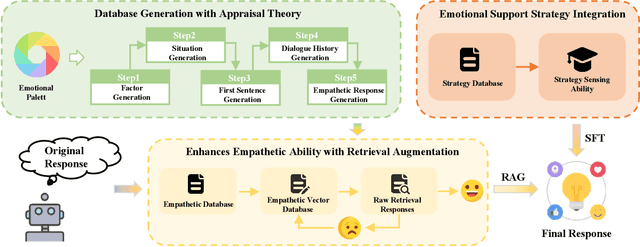
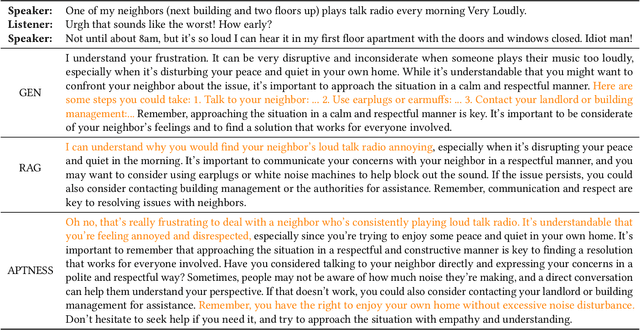
Abstract:Empathetic response generation is designed to comprehend the emotions of others and select the most appropriate strategies to assist them in resolving emotional challenges. Empathy can be categorized into cognitive empathy and affective empathy. The former pertains to the ability to understand and discern the emotional issues and situations of others, while the latter involves the capacity to provide comfort. To enhance one's empathetic abilities, it is essential to develop both these aspects. Therefore, we develop an innovative framework that combines retrieval augmentation and emotional support strategy integration. Our framework starts with the introduction of a comprehensive emotional palette for empathy. We then apply appraisal theory to decompose this palette and create a database of empathetic responses. This database serves as an external resource and enhances the LLM's empathy by integrating semantic retrieval mechanisms. Moreover, our framework places a strong emphasis on the proper articulation of response strategies. By incorporating emotional support strategies, we aim to enrich the model's capabilities in both cognitive and affective empathy, leading to a more nuanced and comprehensive empathetic response. Finally, we extract datasets ED and ET from the empathetic dialogue dataset \textsc{EmpatheticDialogues} and ExTES based on dialogue length. Experiments demonstrate that our framework can enhance the empathy ability of LLMs from both cognitive and affective empathy perspectives. Our code is released at https://github.com/CAS-SIAT-XinHai/APTNESS.
CORI: CJKV Benchmark with Romanization Integration -- A step towards Cross-lingual Transfer Beyond Textual Scripts
Apr 19, 2024Abstract:Naively assuming English as a source language may hinder cross-lingual transfer for many languages by failing to consider the importance of language contact. Some languages are more well-connected than others, and target languages can benefit from transferring from closely related languages; for many languages, the set of closely related languages does not include English. In this work, we study the impact of source language for cross-lingual transfer, demonstrating the importance of selecting source languages that have high contact with the target language. We also construct a novel benchmark dataset for close contact Chinese-Japanese-Korean-Vietnamese (CJKV) languages to further encourage in-depth studies of language contact. To comprehensively capture contact between these languages, we propose to integrate Romanized transcription beyond textual scripts via Contrastive Learning objectives, leading to enhanced cross-lingual representations and effective zero-shot cross-lingual transfer.
Enhancing Cloud-Based Large Language Model Processing with Elasticsearch and Transformer Models
Feb 24, 2024Abstract:Large Language Models (LLMs) are a class of generative AI models built using the Transformer network, capable of leveraging vast datasets to identify, summarize, translate, predict, and generate language. LLMs promise to revolutionize society, yet training these foundational models poses immense challenges. Semantic vector search within large language models is a potent technique that can significantly enhance search result accuracy and relevance. Unlike traditional keyword-based search methods, semantic search utilizes the meaning and context of words to grasp the intent behind queries and deliver more precise outcomes. Elasticsearch emerges as one of the most popular tools for implementing semantic search an exceptionally scalable and robust search engine designed for indexing and searching extensive datasets. In this article, we delve into the fundamentals of semantic search and explore how to harness Elasticsearch and Transformer models to bolster large language model processing paradigms. We gain a comprehensive understanding of semantic search principles and acquire practical skills for implementing semantic search in real-world model application scenarios.
Enhanced User Interaction in Operating Systems through Machine Learning Language Models
Feb 24, 2024Abstract:With the large language model showing human-like logical reasoning and understanding ability, whether agents based on the large language model can simulate the interaction behavior of real users, so as to build a reliable virtual recommendation A/B test scene to help the application of recommendation research is an urgent, important and economic value problem. The combination of interaction design and machine learning can provide a more efficient and personalized user experience for products and services. This personalized service can meet the specific needs of users and improve user satisfaction and loyalty. Second, the interactive system can understand the user's views and needs for the product by providing a good user interface and interactive experience, and then use machine learning algorithms to improve and optimize the product. This iterative optimization process can continuously improve the quality and performance of the product to meet the changing needs of users. At the same time, designers need to consider how these algorithms and tools can be combined with interactive systems to provide a good user experience. This paper explores the potential applications of large language models, machine learning and interaction design for user interaction in recommendation systems and operating systems. By integrating these technologies, more intelligent and personalized services can be provided to meet user needs and promote continuous improvement and optimization of products. This is of great value for both recommendation research and user experience applications.
 Add to Chrome
Add to Chrome Add to Firefox
Add to Firefox Add to Edge
Add to Edge